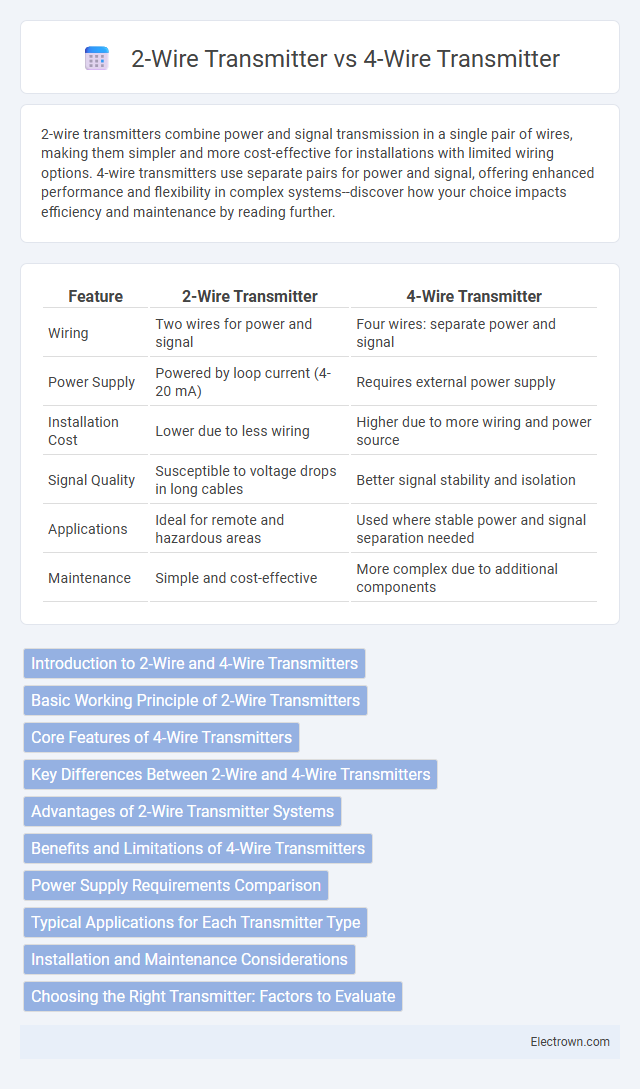2-wire transmitters combine power and signal transmission in a single pair of wires, making them simpler and more cost-effective for installations with limited wiring options. 4-wire transmitters use separate pairs for power and signal, offering enhanced performance and flexibility in complex systems--discover how your choice impacts efficiency and maintenance by reading further.
Table of Comparison
| Feature | 2-Wire Transmitter | 4-Wire Transmitter |
|---|---|---|
| Wiring | Two wires for power and signal | Four wires: separate power and signal |
| Power Supply | Powered by loop current (4-20 mA) | Requires external power supply |
| Installation Cost | Lower due to less wiring | Higher due to more wiring and power source |
| Signal Quality | Susceptible to voltage drops in long cables | Better signal stability and isolation |
| Applications | Ideal for remote and hazardous areas | Used where stable power and signal separation needed |
| Maintenance | Simple and cost-effective | More complex due to additional components |
Introduction to 2-Wire and 4-Wire Transmitters
2-wire transmitters integrate both power supply and signal transmission through two wires, simplifying installation and reducing wiring costs in industrial sensor applications. In contrast, 4-wire transmitters utilize separate pairs for power and signal, allowing for higher signal accuracy and reduced interference in demanding environments. Selection between 2-wire and 4-wire transmitters hinges on factors such as power availability, signal integrity requirements, and system complexity.
Basic Working Principle of 2-Wire Transmitters
2-wire transmitters operate by drawing power and transmitting the output signal through the same two wires, typically using a 4-20 mA current loop for communication. The current loop allows the transmitter to modulate the signal based on the sensed parameter, such as pressure or temperature, while simultaneously receiving power from the loop. This design simplifies wiring and reduces installation costs, making 2-wire transmitters ideal for integrated process control systems.
Core Features of 4-Wire Transmitters
4-wire transmitters feature separate connections for power supply and signal transmission, which enhances signal accuracy and reduces electrical noise interference. These transmitters typically support both analog and digital signals, allowing for versatile integration with various control systems. Your choice of a 4-wire transmitter offers improved reliability in complex industrial environments where precise measurement and stable communication are critical.
Key Differences Between 2-Wire and 4-Wire Transmitters
2-wire transmitters combine power and signal transmission over a single pair of wires, making them ideal for simpler wiring and lower installation costs, while 4-wire transmitters use separate pairs for power and signal, offering better performance and reduced signal interference. The 2-wire design is typically limited to lower power applications, whereas 4-wire transmitters support a wider range of sensor types and higher accuracy due to their dedicated power supply. Your choice depends on application requirements, balancing installation efficiency with signal reliability and device compatibility.
Advantages of 2-Wire Transmitter Systems
2-wire transmitter systems offer significant advantages such as simplified wiring and reduced installation costs by combining power supply and signal transmission within the same cable. These transmitters enhance reliability and ease of maintenance in process control environments by minimizing wiring complexity and potential points of failure. Their compatibility with intrinsic safety standards makes them ideal for hazardous locations, ensuring operational safety and compliance.
Benefits and Limitations of 4-Wire Transmitters
4-wire transmitters offer the benefit of separate power and signal wiring, enabling higher power consumption for enhanced functionality and more accurate signal transmission over longer distances. They support more complex features such as local displays and diagnostics, which are challenging to implement with 2-wire transmitters due to power constraints. A key limitation is the increased wiring cost and complexity compared to 2-wire transmitters, which integrate power and signal on the same pair, making 4-wire setups less suitable for simple, cost-sensitive installations.
Power Supply Requirements Comparison
Two-wire transmitters operate using a single pair of wires that provide both power and signal transmission, typically requiring a lower power supply voltage, often around 24V DC. Four-wire transmitters use separate pairs for power and signal, allowing them to draw higher power and support more complex functions or longer transmission distances. Your choice between these transmitters depends on the power availability and the complexity of the application, with two-wire systems offering simplicity and energy efficiency.
Typical Applications for Each Transmitter Type
2-wire transmitters are commonly used in process control industries for monitoring parameters like temperature, pressure, and flow in environments where power conservation and simple wiring are crucial, such as in hazardous or remote locations. 4-wire transmitters find typical applications in complex industrial automation systems requiring higher accuracy and faster response times, often integrated into systems necessitating separate power supplies for sensor and signal transmission, such as in multivariable process analytics and advanced instrumentation. The choice between 2-wire and 4-wire transmitters depends on factors like installation complexity, environmental conditions, and the precision required for measurement control.
Installation and Maintenance Considerations
2-wire transmitters simplify installation by combining power supply and signal transmission through the same two wires, reducing wiring costs and complexity, especially in hazardous or remote areas. Maintenance is generally easier since fewer connection points mean lower failure rates and quicker troubleshooting, but these transmitters may require compatible 2-wire power sources and can have limited output signal ranges. In contrast, 4-wire transmitters separate power and signal lines, allowing for greater flexibility in power supply options and often providing more accurate signal transmission, but installation involves more wiring and higher labor costs, while maintenance can be more time-consuming due to increased complexity.
Choosing the Right Transmitter: Factors to Evaluate
Choosing the right transmitter depends on application requirements such as power availability, signal integrity, and installation complexity; 2-wire transmitters simplify wiring by drawing power and transmitting signals over the same two wires, ideal for low-power and cost-sensitive setups. 4-wire transmitters, with separate power and signal lines, offer enhanced stability and support higher power consumption, making them suitable for complex and high-accuracy industrial processes. Evaluating environmental conditions, system compatibility, and maintenance needs helps optimize transmitter selection for reliability and performance.
2-wire transmitter vs 4-wire transmitter Infographic

 electrown.com
electrown.com